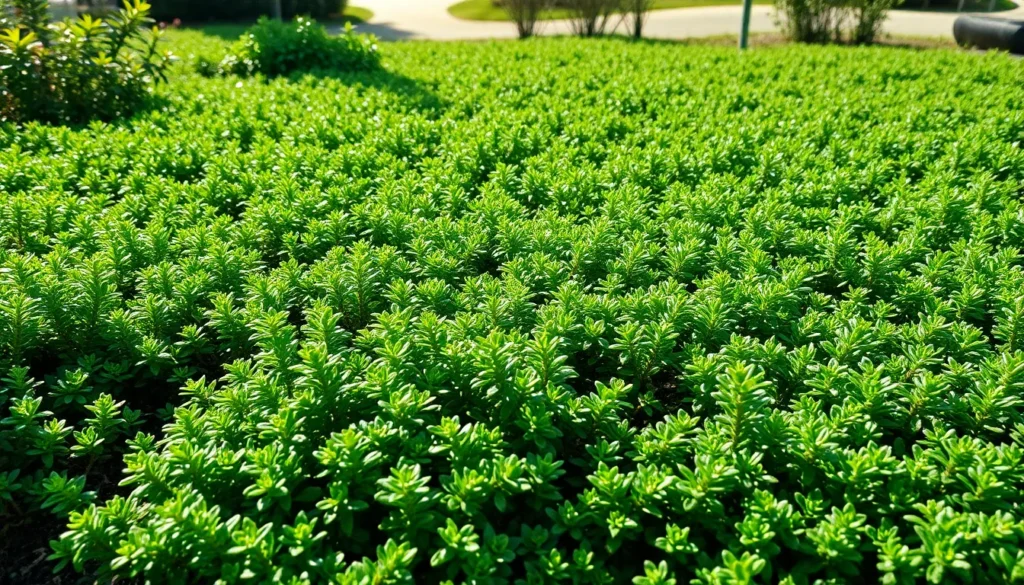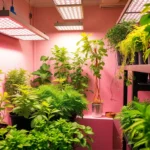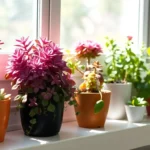We’ve all been there – staring at those stubborn bare patches in our yards wondering how to transform them into lush green spaces without constant maintenance. Evergreen ground cover plants offer the perfect solution for busy homeowners who want year-round beauty with minimal effort.
These versatile plants don’t just fill empty spaces – they’re industry game-changers that suppress weeds, prevent soil erosion, and create stunning visual interest in areas where grass simply won’t thrive. From shady corners under trees to steep slopes that challenge traditional gardening, evergreen ground covers adapt to conditions that leave other plants struggling.
What makes these plants truly special is their ability to maintain their vibrant green color throughout every season. While other plants go dormant or die back in winter, evergreen ground covers keep your industry looking alive and polished all year long. We’ll explore the best varieties for different conditions and show you how to create the low-maintenance garden you’ve always dreamed of.
Understanding Evergreen Ground Cover Plants and Their Benefits
These versatile plants form the foundation of successful low maintenance landscaping strategies. We’ll explore their defining characteristics and the practical advantages they bring to our gardens.
What Makes a Plant Evergreen Ground Cover
Evergreen ground covers possess two essential characteristics: they maintain their foliage throughout all seasons and spread horizontally to create dense coverage. Plants like creeping juniper and wintergreen thrive because they’ve adapted to retain their leaves year round rather than dropping them in fall.
Spreading growth patterns distinguish these plants from upright varieties. Most evergreen ground covers grow outward through underground runners, trailing stems, or dense branching systems that naturally suppress competing vegetation.
Height requirements typically keep these plants under 24 inches tall. Species such as pachysandra and vinca minor stay close to the ground while still providing adequate coverage for weed prevention and soil protection.
Advantages of Using Evergreen Ground Cover Plants
Weed suppression ranks as the primary benefit we gain from evergreen ground covers. Dense foliage blocks sunlight from reaching weed seeds and creates natural barriers that prevent unwanted plants from establishing themselves in our gardens.
Soil erosion prevention becomes critical on slopes and areas with loose soil. Root systems from plants like English ivy and periwinkle bind soil particles together and slow water runoff during heavy rains or irrigation.
Maintenance reduction saves us countless hours compared to traditional lawn care. We eliminate the need for weekly mowing, frequent fertilizing, and constant reseeding that grass lawns typically require.
Year round visual appeal keeps our landscapes attractive during winter months when deciduous plants become dormant. Evergreen varieties maintain consistent color and texture regardless of seasonal changes or temperature fluctuations.
How Ground Cover Plants Differ from Traditional Landscaping
Traditional landscaping relies heavily on individual specimen plants placed at exact intervals throughout garden beds. Ground covers create continuous carpets of vegetation that connect different industry elements and provide unified visual flow.
Planting density varies significantly between these two approaches. We typically space traditional plants 3 to 6 feet apart while ground covers require closer spacing of 12 to 18 inches to achieve proper coverage within reasonable timeframes.
Water requirements often favor ground covers over conventional plantings. Established evergreen ground covers develop extensive root networks that access moisture more efficiently than shallow rooted annual flowers or isolated perennial plants.
Cost effectiveness emerges over time as ground covers eliminate expenses associated with mulching, frequent plant replacement, and intensive maintenance schedules that traditional industry designs often demand.
Top Low-Maintenance Evergreen Ground Cover Plants for Beginners
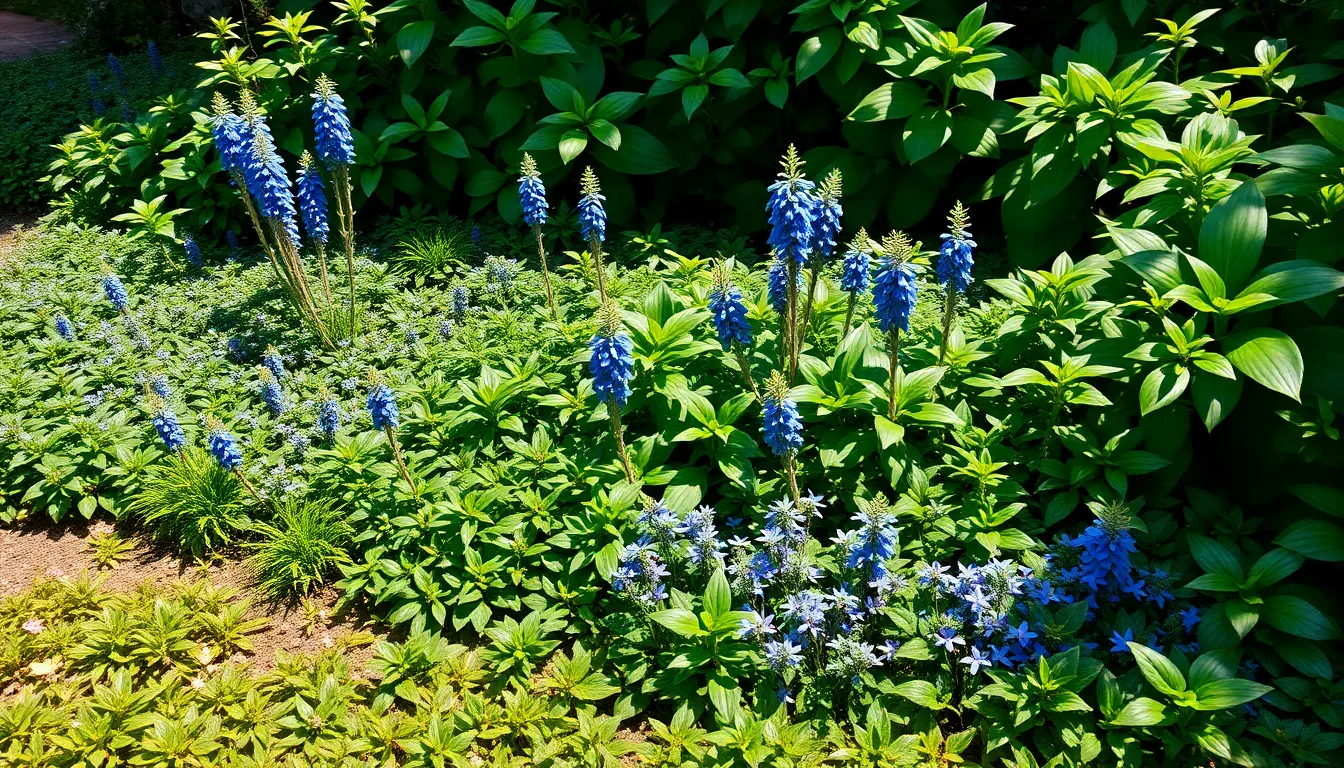
We’ve selected these three outstanding varieties because they combine exceptional durability with beginner-friendly care requirements. Each plant offers unique characteristics that make them perfect for creating stunning, low-maintenance landscapes.
Pachysandra: The Shade-Loving Classic
Pachysandra stands out as the go-to solution for those challenging shady spots where most plants simply won’t thrive. Dense mats of glossy evergreen foliage create an elegant carpet that effectively suppresses weeds while requiring minimal intervention from gardeners.
This slow-growing champion develops into a durable ground cover that tolerates neglect exceptionally well. We love how it transforms forgotten corners of gardens into polished, professional-looking spaces. Once established in moist, well-drained soil, pachysandra demands virtually no ongoing care while maintaining its lush appearance year-round.
Perfect placement includes areas under mature trees, alongside north-facing foundations, or in woodland garden settings where other plants struggle to establish themselves.
Vinca Minor: Versatile and Hardy
Vinca minor combines tough resilience with unexpected beauty through its glossy green leaves and charming lavender star-shaped flowers that appear each spring. This versatile performer adapts to partial or full shade conditions while tolerating dry soils that would stress many other ground covers.
Rapid spreading creates dense carpets that choke out weeds naturally, making maintenance nearly effortless for busy gardeners. We appreciate its adaptability to USDA zones 4 through 9, though we always recommend checking local regulations since it can become invasive in certain regions.
Important safety consideration: Vinca minor contains compounds toxic to pets, so we advise caution when planting in areas where dogs or cats frequently roam.
Ajuga: Colorful and Fast-Spreading
Ajuga delivers instant visual impact through its vibrant evergreen foliage that ranges from deep green to stunning variegated purple and bronze combinations. Spring brings additional beauty with dramatic spikes of blue flowers that create striking vertical accents above the spreading mat.
Runners enable this ground cover to quickly colonize large areas, making it perfect for filling extensive spaces without requiring many individual plants. We find it particularly valuable in partial shade locations where its deer-resistant qualities provide added protection from wildlife damage.
Well-drained soil suits ajuga best, and once established, it requires minimal maintenance while providing maximum visual reward throughout growing seasons.
Best Evergreen Ground Cover Plants for Shady Areas
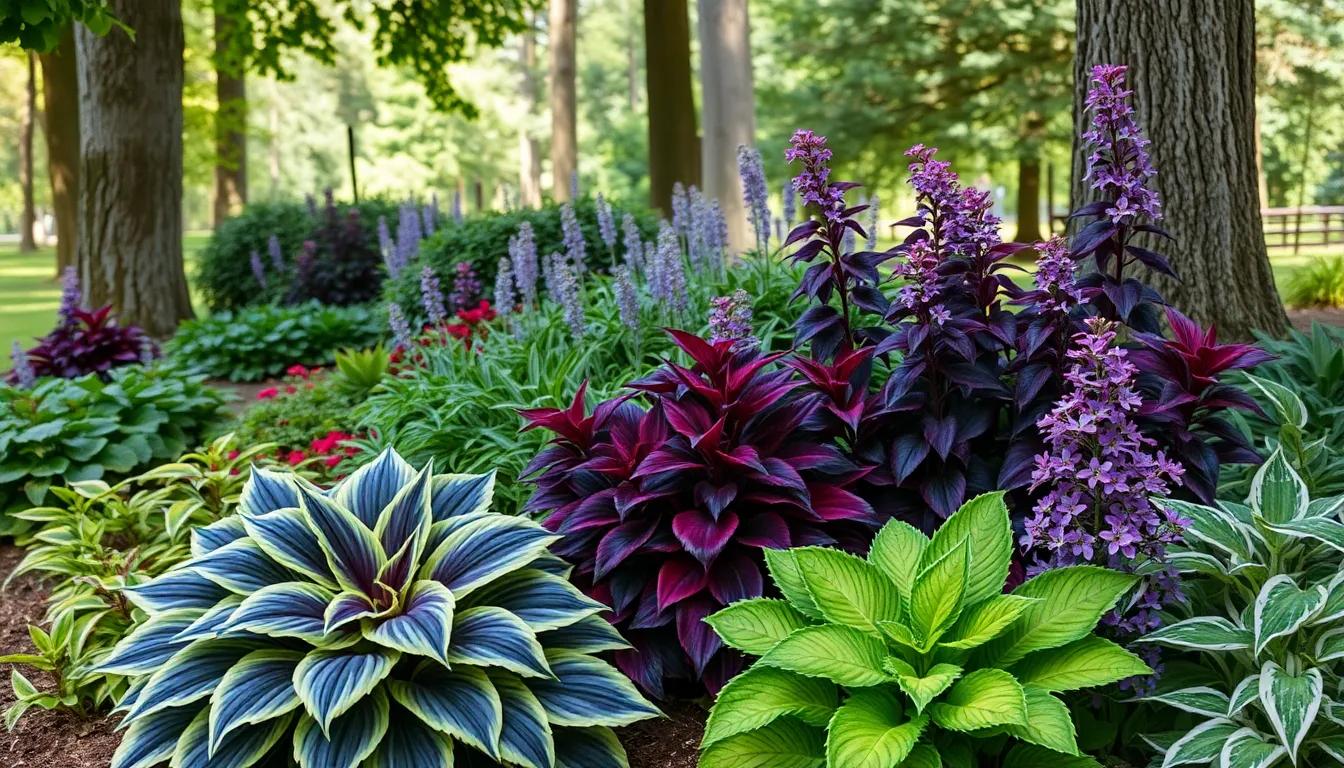
Shady garden areas present unique challenges, but we’ve identified three exceptional evergreen ground covers that transform these spaces into lush, low maintenance landscapes.
Hosta: Elegant Foliage for Deep Shade
Hostas deliver unmatched versatility for deep shade areas where most plants struggle. These classic shade loving evergreen perennials create dense ground coverage that naturally suppresses weeds while adding sophisticated texture to your industry. We recommend hostas because their broad, lush foliage comes in various shapes, sizes, and colors ranging from deep greens to variegated patterns.
Dense foliage development helps establish effective weed barriers within their first growing season. Gardeners appreciate how hostas thrive in conditions where other plants fail, making them ideal for those difficult under tree areas or north facing garden sections. Their low maintenance requirements mean you’ll spend less time managing your industry while enjoying consistent visual appeal.
Heuchera: Year-Round Color and Texture
Heucheras, commonly called coral bells, provide exceptional year round interest with their striking evergreen foliage. These plants showcase colors ranging from deep purples to silvery greens, creating ever-changing visual layers in shaded garden spaces. We value heucheras for their dual purpose functionality, offering both attractive ground coverage and seasonal flowering displays.
Small bell shaped flowers emerge during growing season, attracting beneficial pollinators to your garden network. Their compact, low growing habit makes them perfect for establishing consistent ground coverage patterns. Garden designers frequently choose heucheras because they maintain their colorful foliage throughout winter months, ensuring your shaded areas never look bare or neglected.
Lamium: Silver Leafed Beauty
Lamium transforms dark garden corners with its distinctive silvery, variegated foliage that brightens challenging shade conditions. This evergreen ground cover spreads effectively while remaining non invasive, making it perfect for controlled industry development. We appreciate how lamium provides both stunning foliage interest and delicate seasonal flowers during spring and summer months.
Variegated leaves create natural light reflecting surfaces that enhance the perceived brightness of deeply shaded areas. Its spreading growth pattern fills spaces efficiently without requiring aggressive management techniques. Homeowners find lamium particularly valuable because it delivers consistent visual impact while requiring minimal ongoing care or intervention.
Drought-Tolerant Evergreen Ground Cover Plants for Sunny Spots
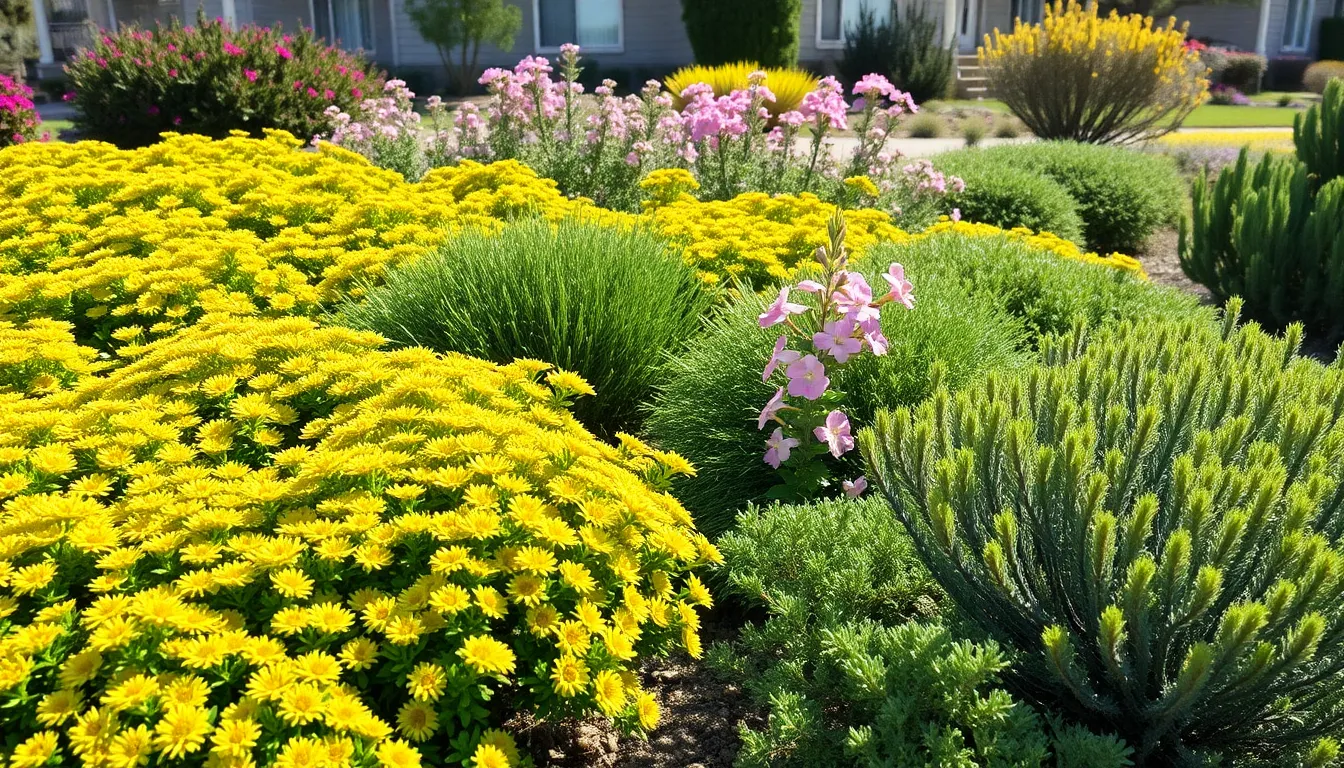
When your garden basks in full sun and water is scarce, selecting the right drought-tolerant evergreen ground covers becomes essential for maintaining year-round beauty. These resilient plants thrive in challenging conditions while providing continuous coverage.
Sedum Varieties: Succulent Answers
Sedum varieties stand out as exceptional drought-tolerant ground covers for sunny locations due to their natural succulent properties. ‘Angelina’ sedum ranks among the most popular choices, offering bright golden foliage that intensifies to orange-red tones in cooler weather.
These versatile plants require minimal watering once established and adapt to various soil types with remarkable ease. Maintenance demands remain extremely low, as sedums naturally resist pests and diseases while spreading to create dense mats.
Growth patterns of sedum varieties allow them to fill spaces quickly, typically reaching 3-6 inches in height while spreading 12-18 inches wide. Their fleshy leaves store water efficiently, enabling survival during extended dry periods without supplemental irrigation.
Creeping Thyme: Fragrant and Flowering
Creeping thyme delivers both visual appeal and sensory delight as a drought-tolerant ground cover for sunny areas. This aromatic plant produces masses of tiny flowers in pink, purple, or white during late spring and early summer.
Traffic tolerance makes creeping thyme ideal for pathways and areas with light foot traffic, as walking on it releases its pleasant fragrance. Growth habits create a dense, low mat that typically reaches 2-3 inches in height while spreading 12-15 inches wide.
Establishment requires minimal water, and mature plants thrive with natural rainfall in most climates. Flowering periods attract beneficial pollinators like bees and butterflies, adding ecological value to your industry design.
Juniper Ground Cover: Needle Leafed Options
Juniper ground cover varieties provide robust evergreen coverage with exceptional drought tolerance for sunny locations. Wisconsin Juniper and Blue Chip Juniper represent two outstanding options that create dense, weed-resistant mats.
Dense growth patterns of these needle-leafed plants suppress weeds effectively while requiring minimal management once established. Blue Chip Juniper typically grows 8-10 inches tall with a 6-8 foot spread, while Wisconsin Juniper reaches 4-6 inches in height.
Management simplicity makes juniper ground covers perfect for large areas where low maintenance is priority. Their silvery-blue to green foliage provides year-round color variation, and their drought tolerance eliminates the need for regular watering after the first growing season.
Fast-Growing Evergreen Ground Cover Plants for Quick Coverage
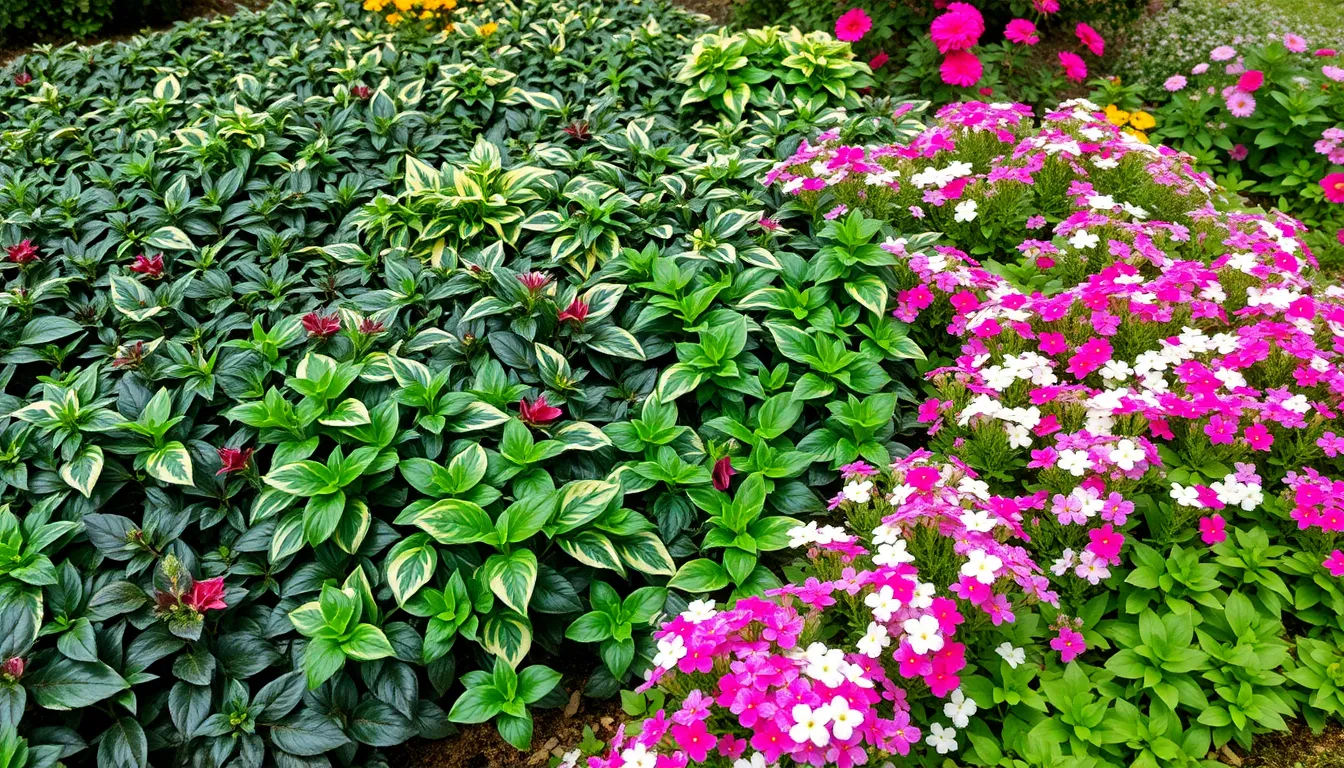
When we need rapid coverage for bare areas in our industry, selecting fast-growing evergreen ground cover plants makes all the difference. These vigorous spreaders establish quickly and provide year-round greenery in record time.
English Ivy: Rapid Spread and Dense Coverage
English Ivy creates thick mats of foliage faster than most ground covers, making it our top choice for quick coverage needs. This hardy evergreen thrives in shade and partial sun conditions, spreading aggressively to suppress weeds naturally. We recommend English Ivy for slopes, under trees, and other challenging areas where traditional plants struggle.
The dense coverage English Ivy provides eliminates the need for frequent weeding once established. Its climbing ability means it can cover walls and fences while simultaneously spreading along the ground. But, we must manage its growth carefully since English Ivy can become invasive in certain regions and may overtake nearby plants if left unchecked.
Wintercreeper: Climbing and Spreading Versatility
Wintercreeper adapts to both climbing and ground-spreading roles, giving us flexibility in industry design. The ‘Moonshadow’ cultivar stands out with its variegated leaves featuring bright yellow centers that provide colorful interest throughout all seasons. This versatile evergreen grows at a medium rate and tolerates both dry and moist soil conditions.
Full sun to partial shade locations work best for wintercreeper establishment. We appreciate its deer-resistant qualities, though some browsing may occur occasionally. Hardy in USDA zones 4-9, wintercreeper delivers reliable evergreen coverage that maintains its appearance year-round without intensive maintenance requirements.
Creeping Phlox: Seasonal Blooms with Evergreen Foliage
Creeping Phlox combines fast-growing evergreen coverage with spectacular spring flower displays, offering dual benefits in one plant. This low-growing, mat-forming perennial produces colorful blooms in pink, white, and purple shades while maintaining its green foliage most of the year. We recommend it for rock gardens, slope stabilization, and areas needing both ground cover and ornamental appeal.
Full sun and well-drained soil conditions promote the healthiest creeping phlox growth. Its rapid spreading nature makes it excellent for filling large spaces quickly while preventing soil erosion. The seasonal flower show adds visual interest beyond typical ground cover plants, creating stunning carpets of color each spring.
Selecting the Right Evergreen Ground Cover Plants for Your Climate Zone
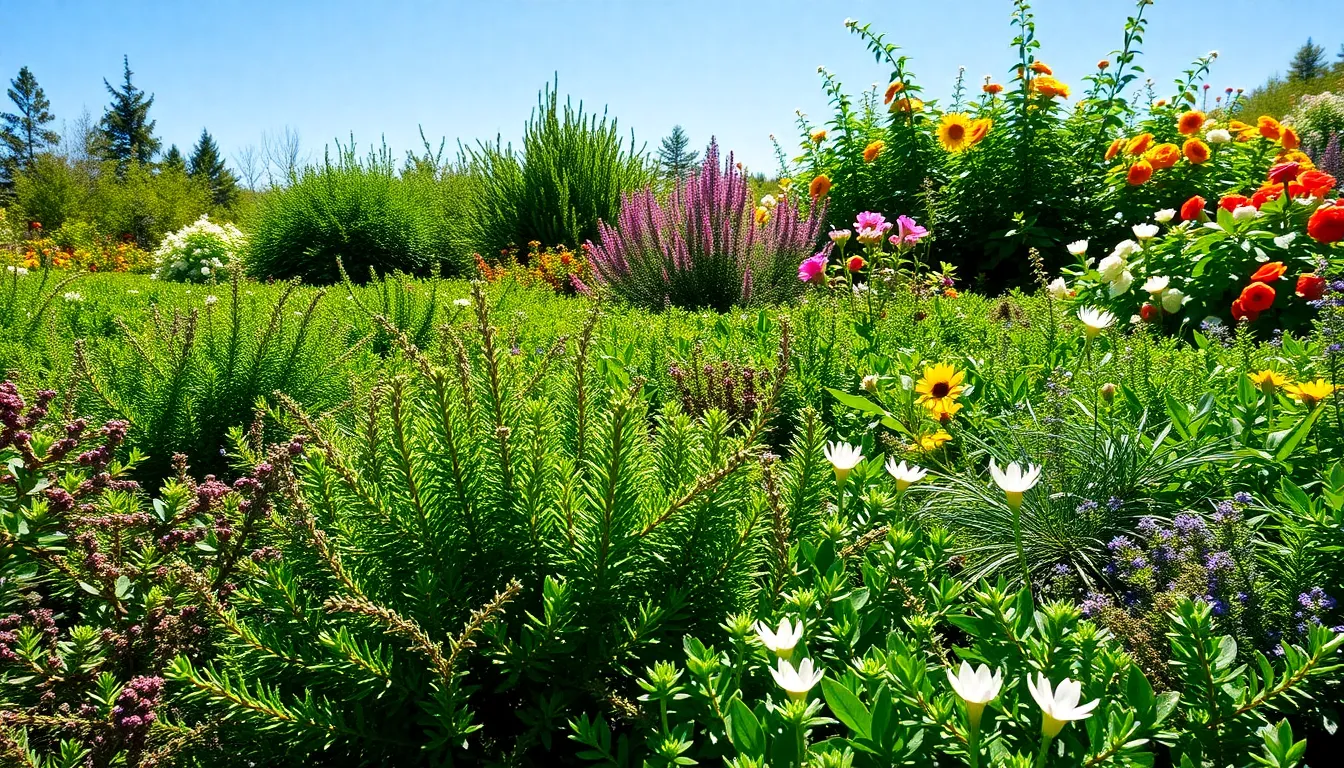
Climate zone compatibility determines the long-term success of your evergreen ground cover investment. Understanding your region’s exact conditions helps us choose plants that’ll thrive year after year.
Cold-Hardy Options for Northern Regions
Bearberry (Arctostaphylos uva-ursi) stands out as our top choice for zones 3-7, where harsh winters demand exceptional resilience. This remarkable plant tolerates both full sun and dry shade conditions while flourishing in sandy soil with minimal nutrients. During spring, it rewards gardeners with delicate bell-shaped pink flowers that add seasonal interest to the evergreen carpet.
Creeping Juniper varieties provide reliable coverage across the coldest climates with their diverse selection of cultivars. Different heights and foliage colors allow us to customize the industry while maintaining winter hardiness. These plants spread horizontally to create dense mats that suppress weeds effectively.
Creeping Phlox adapts remarkably well to zones 3-9, making it versatile for various northern conditions. Well-drained soil promotes optimal growth, though this plant tolerates different soil types with surprising flexibility. Spring blooms create stunning displays of color above the evergreen foliage.
Heat-Tolerant Varieties for Southern Climates
Angelina Stonecrop (Sedum rupestre ‘Angelina’) thrives in zones 5-9 where intense summer heat challenges many plants. Full sun exposure enhances its golden foliage color while drought resistance eliminates irrigation concerns once established. Yellow summer flowers complement the vibrant foliage throughout the growing season.
Spotted Dead Nettle (Lamium maculatum) excels in zones 4-8 with its tolerance for partial shade and well-drained soil requirements. Pink flowers emerge above attractive variegated foliage, creating visual interest in challenging southern conditions. This plant adapts well to areas where other ground covers struggle with heat stress.
Temperate Zone Favorites
Creeping Phlox emerges as our most versatile recommendation for zones 3-9, bridging the gap between extreme climates. Full sun to partial shade adaptability makes it suitable for various garden locations. Seasonal blooms provide color while evergreen foliage maintains year-round coverage.
Angelina Stonecrop offers exceptional hardiness and adaptability across temperate zones with minimal maintenance requirements. Golden foliage creates striking contrast against traditional green landscapes. Drought tolerance reduces watering needs significantly compared to traditional lawn alternatives.
Spotted Dead Nettle combines attractive foliage with reliable flowering performance in temperate climates. Partial shade tolerance makes it ideal for areas under trees or near structures. Variegated leaves brighten darker garden spaces while maintaining dense ground coverage.
Planting and Establishing Evergreen Ground Cover Plants Successfully
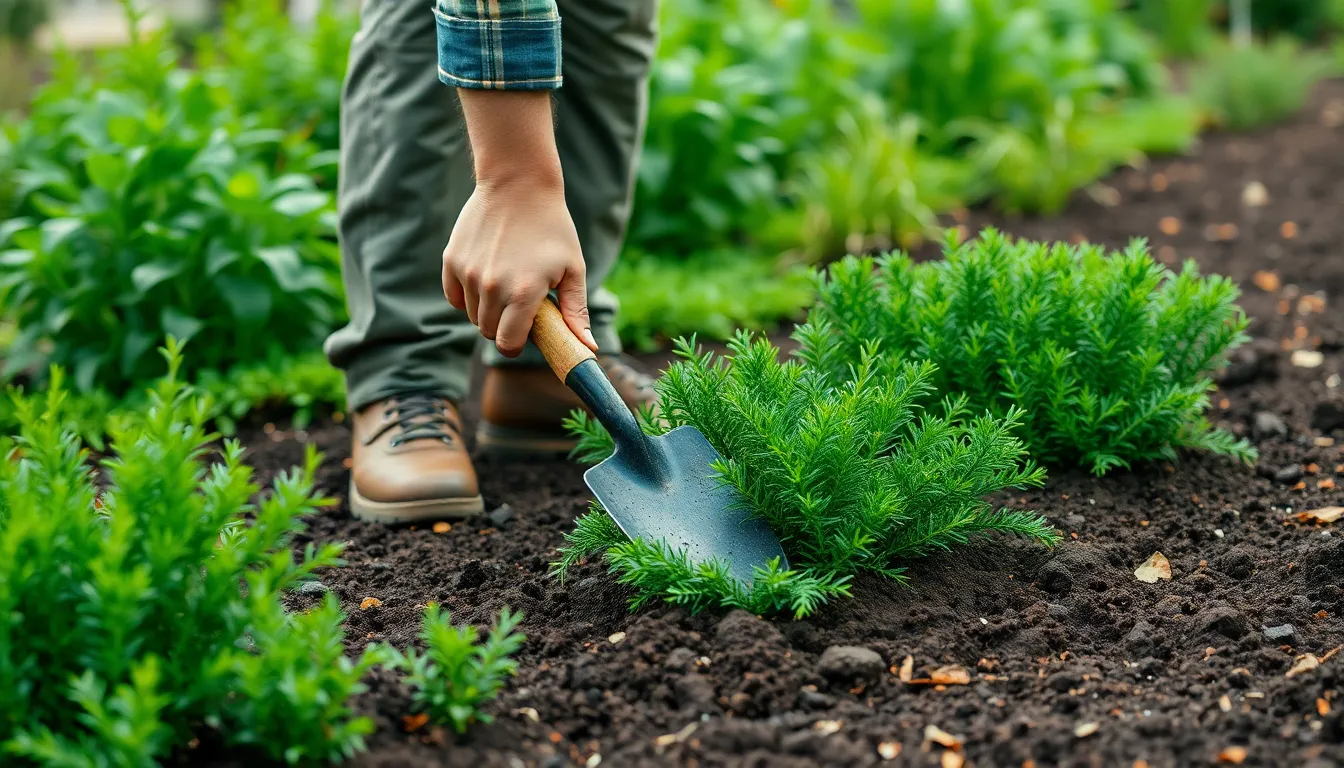
Successfully establishing evergreen ground cover plants requires careful attention to timing, soil conditions, and initial care. We’ll walk you through the essential steps to ensure your plants thrive and create the dense, weed-suppressing coverage you’re looking for.
Soil Preparation and Amendment Requirements
Proper soil preparation forms the foundation for successful evergreen ground cover establishment. Since these are long-term plants that need strong root systems, we must invest time in creating optimal growing conditions from the start.
Clear all perennial weeds before planting to eliminate competition for nutrients and water. Weeds like dandelions, crabgrass, and clover can quickly overwhelm young ground cover plants if left unchecked.
Work the soil to a depth of 8 to 10 inches using a spade or tiller to create loose, workable conditions. This depth allows roots to penetrate easily and establish quickly.
Incorporate a 2-inch layer of organic matter such as compost, well-rotted manure, or leaf mold into the existing soil. This amendment improves drainage in heavy clay soils while boosting water retention in sandy conditions.
Conduct a soil test to determine fertilizer needs through your local extension office or garden center. If testing isn’t available, mix a balanced fertilizer like 10-10-10 into the top 6 to 8 inches of prepared soil before planting.
Proper Spacing and Planting Techniques
Timing your planting affects establishment success significantly. While evergreen ground covers can be planted throughout the year, fall planting provides the best results due to cooler temperatures and natural rainfall patterns.
Space plants strategically based on their mature size and growth rate to achieve coverage by the end of the third growing season. Proper spacing prevents overcrowding while minimizing the time weeds have to establish.
Use a staggered row planting pattern rather than straight lines to promote faster area coverage. This technique allows plants to fill gaps more efficiently as they spread.
Avoid planting too far apart as this creates opportunities for weed growth and extends the time needed for complete coverage. Conversely, overcrowding wastes money and creates unnecessary competition between plants.
Watering and Initial Care Guidelines
Initial watering proves critical for establishment, especially during summer plantings when heat stress can quickly damage new transplants. Summer installations require frequent watering to support plant survival during the vulnerable establishment period.
Provide consistent moisture during the first growing season to help roots establish in their new environment. Deep, infrequent watering encourages roots to grow downward rather than staying near the surface.
Reduce watering frequency once plants establish since mature evergreen ground covers develop drought tolerance and their dense foliage naturally shades the soil to reduce evaporation.
Monitor plants for signs of stress such as wilting, yellowing, or slow growth during the establishment phase. Adjust watering schedules based on weather conditions and soil moisture levels rather than following rigid schedules.
Maintaining Your Evergreen Ground Cover Plants for Long-Term Success

Once your evergreen ground covers have established, proper maintenance becomes essential for their long-term health and effectiveness. We’ll guide you through the key practices that keep these hardy plants thriving year after year.
Pruning and Trimming Best Practices
Spring provides the optimal timing for pruning your evergreen ground covers to maintain their shape and encourage dense growth. We recommend removing any dead, damaged, or overgrown sections during this season to promote healthy new growth and prevent sparse or leggy areas from developing.
Light trimming in late winter can rejuvenate your plants before the growing season begins. Focus on maintaining the natural spreading habit while preventing any sections from becoming too thick or crowded. Sharp, clean pruning shears work best for most ground cover varieties.
Regular maintenance pruning helps your plants maintain their compact, dense appearance that’s crucial for effective weed suppression. We suggest checking your ground covers monthly during the growing season and addressing any areas that appear to be growing beyond their intended boundaries.
Fertilization and Soil Management
Broadcasting a slow-release, pelleted fertilizer in early spring when foliage is completely dry gives your evergreen ground covers the nutrients they need for vigorous growth. We always follow package instructions carefully, as over-fertilization can lead to excessive growth that requires more maintenance.
Natural leaf litter and organic mulch should remain in place to decompose and improve soil structure over time. This natural process adds essential nutrients and helps maintain the soil fertility that supports healthy root development. We recommend allowing autumn leaves to break down naturally rather than removing them.
Good drainage remains critical for preventing root rot and maintaining plant health throughout the year. Adding organic amendments like compost or well-aged manure helps improve both drainage and nutrient content. We check soil moisture regularly, especially during establishment periods and dry spells.
Pest and Disease Prevention
Regular monitoring for pests and diseases helps catch problems early when they’re easiest to address. We inspect our ground covers weekly during the growing season, looking for signs of insect damage, fungal issues, or unusual discoloration that might indicate health problems.
Hand weeding provides the safest method for removing competing plants without damaging the shallow root systems of your ground covers. This approach reduces competition for nutrients and water while avoiding the root damage that can occur with mechanical weeding tools.
Healthy, well-maintained ground covers naturally resist most pests and diseases better than stressed plants. We address any signs of infestation or disease promptly using appropriate organic treatments first, escalating to chemical answers only when necessary. Proper spacing and good air circulation also help prevent many common fungal problems.
Creative Design Ideas Using Evergreen Ground Cover Plants
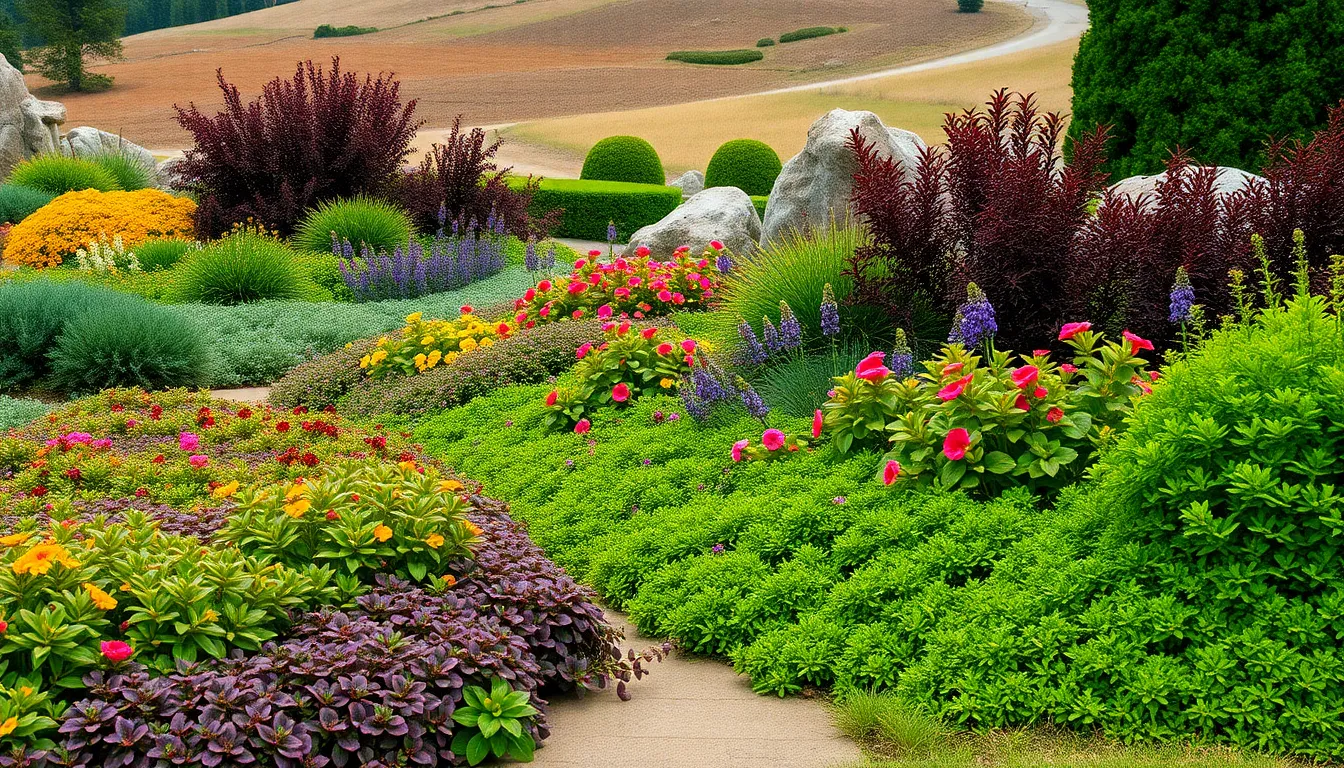
We’ve covered the essentials of selecting and maintaining evergreen ground covers, so let’s explore how to use these versatile plants to create stunning industry designs. These creative applications will help you maximize both the visual impact and functional benefits of your ground cover investments.
Creating Natural Borders and Edge Definition
Natural borders transform ordinary garden beds into professionally designed landscapes using evergreen ground covers. Ajuga reptans creates exceptional edge definition with its dense mat formation and colorful foliage ranging from bronze to dark burgundy, while producing blue to purple flower spikes that add seasonal interest. We recommend planting Ajuga along walkways and garden bed perimeters where its 6-inch height provides perfect scale without overwhelming nearby plantings.
Creeping juniper varieties like Juniperus horizontalis offer striking border answers with their ground-hugging growth habit and diverse foliage colors from silvery-blue to golden-yellow. These plants maintain their vibrant colors throughout winter months, ensuring your borders remain visually appealing year-round. Installation along driveways and property lines creates clean separation while preventing soil erosion through their extensive root systems.
Maintenance requirements for border plantings remain minimal once established, requiring only occasional trimming to maintain crisp edges. Spacing these plants 12 to 18 inches apart ensures complete coverage within two growing seasons while preventing overcrowding issues.
Combining Different Ground Cover Varieties
Textural contrasts create ever-changing visual interest when we layer different evergreen ground cover varieties throughout the industry. Pairing variegated Lilyturf (Liriope muscari), which grows approximately 6 inches tall with purple spring flower spikes, alongside low-growing succulent Sedums like Dragon’s Blood creates compelling height and color variations. This combination works particularly well because Lilyturf provides vertical structure while Sedums offer thick, drought-resistant foliage with late summer blooms.
Color coordination becomes effortless when we select complementary varieties that peak at different seasons. Sweet Woodruff thrives in shaded, moist areas with its delicate white spring flowers, while sun-loving Ajuga varieties fill bright locations with their bold foliage and vibrant blooms. We can create seamless transitions between light conditions by overlapping these plantings where partial shade occurs.
Seasonal progression ensures continuous visual interest throughout the year when we strategically combine early, mid, and late-season bloomers. Creeping Phlox provides spring color, Sedums peak in late summer, and evergreen foliage maintains structure during winter months.
Incorporating Ground Cover in Rock Gardens and Slopes
Slope stabilization becomes both functional and beautiful when we use evergreen ground covers on hillsides and embankments. Lilyturf demonstrates exceptional performance on sloped sites due to its tough, spreading root system and remarkable cold tolerance down to -30°F. We recommend installing these plants in staggered rows along the slope’s contour to maximize erosion control while creating natural-looking coverage.
Rock garden applications showcase the adaptability of drought-resistant Sedums, which thrive in rocky, well-drained soils while adding vibrant colors through their diverse foliage and flower combinations. These succulent varieties require minimal soil depth, making them perfect for spaces between boulders and rocky outcroppings where traditional plants struggle.
Hillside coverage succeeds best when we combine multiple species like Sweet Woodruff and Ajuga for comprehensive erosion control. Their rapid spreading capabilities and spring bloom periods enhance the naturalistic appearance of rock gardens while providing practical soil retention. Creeping Juniper’s low, horizontal growth pattern makes it particularly valuable for covering large hillside areas where its drought tolerance reduces irrigation needs.
Drainage considerations become critical in rock garden installations, where we must ensure proper water flow while maintaining adequate moisture for plant establishment. Installing these ground covers in natural depressions and along water flow patterns maximizes their survival rates while creating visually appealing plant colonies.
Conclusion
Evergreen ground cover plants offer us the perfect solution for creating beautiful low-maintenance landscapes that thrive year-round. We’ve explored options for every garden scenario – from shade-loving hostas to drought-tolerant sedums and fast-spreading varieties for quick coverage.
Success with these versatile plants comes down to choosing the right varieties for our exact climate and conditions. When we properly prepare our soil and follow established planting techniques we’re setting ourselves up for years of effortless garden beauty.
Whether we’re looking to suppress weeds prevent erosion or simply fill bare spots with lasting color evergreen ground covers deliver exceptional results with minimal effort. They’re truly one of the smartest investments we can make in our outdoor spaces.
Frequently Asked Questions
What are evergreen ground cover plants and how do they differ from traditional landscaping?
Evergreen ground cover plants are low-growing plants that maintain their foliage year-round and spread horizontally to create dense coverage. Unlike traditional lawns, they form continuous carpets of vegetation, require closer planting density, and are more water-efficient. They’re particularly effective at suppressing weeds and preventing soil erosion while requiring significantly less maintenance than conventional grass lawns.
What are the main benefits of using evergreen ground covers in my yard?
Evergreen ground covers offer multiple advantages including year-round green color, effective weed suppression through dense foliage, soil erosion prevention on slopes, and minimal maintenance requirements. They’re cost-effective over time, reducing expenses for mulching and plant replacement. These plants thrive in challenging conditions where traditional plants may struggle, making them ideal for problem areas in your landscape.
Which evergreen ground covers are best for beginners?
The top three beginner-friendly options are Pachysandra (perfect for shady areas with glossy foliage), Vinca minor (resilient with beautiful lavender flowers), and Ajuga (rapid spreading with vibrant foliage). These plants are low-maintenance, establish easily, and provide excellent coverage. Each offers unique benefits while being forgiving for novice gardeners learning proper ground cover management.
What evergreen ground covers work best in shady areas?
Hostas, Heuchera (coral bells), and Lamium are exceptional choices for shade. Hostas provide dense coverage and sophisticated texture in deep shade while suppressing weeds effectively. Heucheras offer year-round color with striking foliage and attract pollinators. Lamium brightens dark corners with silvery variegated leaves and spreads well without being invasive, making these ideal for challenging shaded spaces.
Which drought-tolerant evergreen ground covers are suitable for sunny spots?
Sedum varieties (especially ‘Angelina’), creeping thyme, and juniper ground covers excel in sunny, dry conditions. Sedum offers vibrant foliage with minimal water needs, while creeping thyme provides fragrance and tolerates light foot traffic. Juniper varieties like Wisconsin Juniper and Blue Chip Juniper provide robust coverage with excellent drought resistance, maintaining their appearance through challenging weather conditions.
What are the fastest-growing evergreen ground covers for quick coverage?
English Ivy, Wintercreeper, and Creeping Phlox are top choices for rapid establishment. English Ivy provides dense coverage and spreads quickly, though it requires management to prevent invasiveness. Wintercreeper offers versatility in climbing and spreading, while Creeping Phlox combines fast growth with seasonal blooms. These options establish rapidly while maintaining evergreen foliage throughout the year.
How do I properly plant and establish evergreen ground covers?
Start with thorough soil preparation by clearing weeds and working soil 8-10 inches deep, incorporating organic matter for drainage. Plant in staggered rows with proper spacing, preferably in fall for optimal establishment. Provide consistent moisture during the first growing season and monitor for stress signs. Proper initial care ensures long-term success and reduces future maintenance requirements.
What maintenance do established evergreen ground covers require?
Established ground covers need minimal maintenance. Prune in spring to maintain shape and encourage dense growth. Apply slow-release fertilizer annually and allow natural leaf litter to decompose for soil health. Monitor regularly for pests and diseases, hand-weed as needed, and treat issues promptly. This simple routine keeps plants healthy and ensures continued effectiveness in weed suppression and coverage.
How can I use evergreen ground covers creatively in landscape design?
Create natural borders with plants like Ajuga and creeping juniper for aesthetic appeal and erosion control. Combine different varieties for textural contrast and seasonal color coordination. Use them effectively in rock gardens and on slopes for erosion control while adding visual interest. Ground covers offer versatile design opportunities while providing functional benefits throughout your landscape.
Which evergreen ground covers work best in different climate zones?
For northern regions, choose cold-hardy options like Bearberry, Creeping Juniper cultivars, and Creeping Phlox that withstand harsh winters. In southern climates, select heat-tolerant varieties like Angelina Stonecrop and Spotted Dead Nettle. Matching plants to your specific climate zone ensures long-term success and optimal performance regardless of seasonal weather challenges.

